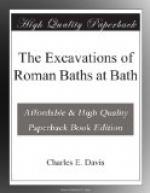’When, as we may suppose, they have run a length
proportionable to their width, they compose a bath,
which may indeed be called great, 96ft. by 68ft.’
The fact is, Sutherland supposed that the dimensions
of the great Roman Bath would observe the same relative
proportions as Lucas’s Bath. The room of
Lucas’s Bath, let it be remembered, was 43ft.
by 34ft., or rather 30ft. 6in. from the face of the
pilasters. In other words, the length was equal
to the diagonal of the square of the base. Then,
having observed that the base of the room of the great
Roman Bath—formed by the length of Lucas’s
Bath—was 68ft., Sutherland assumed that
its length also would be equal to the diagonal of
the square of base, namely 96ft. This patent
error, assuming that the unknown would have a relative
correspondence with the known quantities, was the
fruitful source of many more. (1) The dimensions of
the outer rectangular area formed by the room of the
great Roman Bath being false, the dimensions of the
inner rectangular area formed by the water surface
of the bath were necessarily false also. (2) Steps
were observed at one end only of the water surface
of Lucas’s Bath; therefore it was inferred that
steps would be found at one end only of the water
surface of the great bath, the eastern end as figured
in the maps of 1763 and 1864, whereas we now know that
steps run all round. (3) The exedrae at the
back of the schola having no existence in Lucas’s
Bath, were omitted from the conjectural plan of the
great Roman Bath. (4) Lucas’s Bath being a plain
hall without piers, Sutherland assumed the same form
for the hall of the great Roman Bath, and altogether
omitted the arcades that divide it into three aisles.
(5) Not to dwell on other errors built on the baseless
fabric of conjecture, it is evident that Sutherland
imagined a system of baths existed west of the great
Roman Bath similar in all respects to that known to
exist east of the great Roman Bath. But here,
again, theory has been upset by facts. And now
is a fitting opportunity to draw attention to what
has been actually discovered west of the great Roman
Bath, namely, the octagon Roman Well, which I should
be disposed to consider Major Davis’s greatest
discovery, though I observe that hostile critics take
no notice of this, possibly because it is beyond the
region of dispute. If any one, able to point
what he reads, still believes that the great Roman
Bath was ever practically opened up in the last century
I would refer him to Mr. Moore’s able and suggestive
paper, entitled ’Organisms from the recently
discovered Roman Baths in Bath,’ read to the
members of the Bath Microscopical Society, in May,
1883. Once more I insist that we must clearly
separate what Sutherland knew from what he conjectured.
Indeed, Sutherland himself fairly draws the distinctions.
On page 21 he says, ’This ground plot is exhibited
in the plate annexed, as far as the earth is cleared
away. The remainder is supposed, and drawn out




